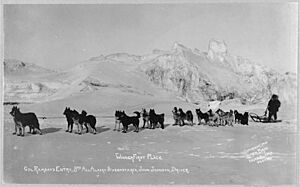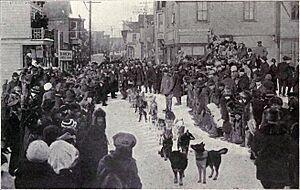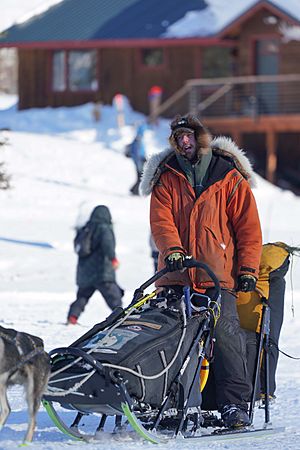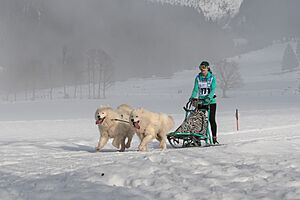Sled dog racing facts for kids
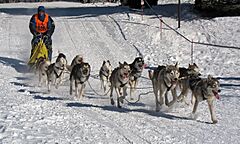
An 11-dog team of Siberian Huskies, racing in Frauenwald, Thuringia, Germany, in 2012
|
|
| Highest governing body | International Federation of Sleddog Sports (IFSS) |
|---|---|
Sled dog racing is an exciting winter sport. It is popular in cold places like the Arctic regions of the United States, Canada, Russia, Greenland, and parts of Europe. In this sport, teams of special sled dogs pull a dog sled across snow or ice. A person called a musher stands on the sled's runners. The goal is to finish a marked course in the fastest time.
Sled dogs are very well-trained animals. They are also known as sleighman dogs or sledge dogs. These dogs wear special harnesses and lines. They use these to pull the sled, which is a vehicle without wheels, over snowy or icy paths.
The Exciting World of Sled Dog Racing
A Look Back: The History of Dog Sledding
Sled dog racing has a long and exciting past. The first recorded race in North America was the All Alaska Sweepstakes. It happened in Alaska in 1908. This tough race covered 400 miles from Nome to Candle and back.
The first winner, John Hegness, finished in about 119 hours. By 1910, teams were much faster. John "Iron Man" Johnson won the third race in a record 74 hours. This record still stands today!
Famous Early Races and Heroes
The American Dog Derby started in 1917. It is the oldest dog sled race in the U.S. that still happens every year. This race became very famous, like the Kentucky Derby for horse racing. Mushers became international stars.
In 1929, the Laconia World Championship Sled Dog Race began in New Hampshire. A legendary musher named Leonhard Seppala won the first race. He was famous for his role in the 1925 "Great Race of Mercy". His lead dogs, Togo and Balto, were also heroes. The Laconia race is still held annually, over 90 years later.
Sled dog racing was even a special "demonstration sport" at the 1932 Winter Olympics in Lake Placid, New York. It also appeared at the 1952 and 1994 Winter Olympics. However, it never became an official Olympic event.
The Iditarod: A Legendary Challenge
The Iditarod Trail Sled Dog Race is perhaps the most famous race of all. People call it the "Last Great Race on Earth." It covers about 1,000 miles (1,600 km) of very difficult land in Alaska. Mushers and their teams face mountains, frozen rivers, thick forests, and wide-open tundras.
Teams of 12 to 16 dogs travel from Anchorage to Nome. The race remembers the 1925 serum run to Nome. This was when dog teams delivered life-saving medicine. The modern Iditarod race started in 1973. Joe Redington and his supporters helped make it happen. The Iditarod helped bring back worldwide interest in mushing.
Today, sled dog races happen all over the world. You can find them in Norway, Finland, Alaska, and Michigan. Most races take place in winter because of the cold. But some "dryland races" use carts instead of sleds. These can happen in warmer weather.
A race called the Klondike Dog Derby restarted in 2020. It is a 40-mile race around Lake Minnetonka in Minnesota. Many other popular races are held in the northern U.S., Canada, and Alaska. These include the John Beargrease Sled Dog Marathon and the Apostle Island Sled Dog Race.
How Sled Dog Races Work
Different Race Distances
Sled dog races come in different lengths.
- Sprint races are shorter, usually 5 to 30 miles per day. They often last two or three days.
- Mid-distance races cover 30 to 300 miles in total.
- Long-distance races are the longest, from 300 miles to over 1,000 miles. The Iditarod is a great example of a long-distance race.
Races are also grouped by how many dogs are on a team. Common team sizes are four, six, eight, or ten dogs. Some races have an "unlimited" or "open" category for even larger teams.
Starting the Race: Timed vs. Mass Starts
There are two main ways races begin:
- Timed starts: Teams start one after another, a few minutes apart. They race against the clock to get the best time. This helps keep things organized at the start line.
- Mass starts: All the dog teams start at the same time! This is popular in Europe and Canada. Imagine 30 teams, or 300 dogs, all starting together!
Rules and Fair Play
Many races follow rules set by international groups. These groups include ISDRA (International Sled Dog Racing Association) in North America. ESDRA (European Sled Dog Racing Association) handles races in Europe. The IFSS (International Federation of Sleddog Sports) organizes World Cup races.
These rules ensure safety and fairness. For example, race trails must be safe and clearly marked. Mushers must always treat their dogs kindly. Using performance-enhancing substances is strictly against the rules.
Racing Without Snow: Dryland Mushing
Not all sled dog races need snow! In dryland sled dog racing, competitors use different equipment. They might use a special cart with wheels, a scooter, or a bicycle (bikejoring). Some even run on foot (canicross) with their dogs. These races happen on dirt trails. Dryland racing is popular in places like Australia, where there isn't much snow.
Another type is the freight race. In this race, dogs pull a specific amount of weight in the sled. These races usually have smaller teams, with 1 to 5 dogs.
The Sled and the Team
A racing sled dog wears its own harness. A "tugline" connects the harness to a central "gangline." Dogs are usually hooked up in pairs. Short "necklines" keep the dogs in their correct positions. You usually won't see more than 22 dogs on a racing team. This number is often only for the first day of big sprint events. Mushers can remove dogs from their team on later days, but they cannot add new ones. Many rules like these have been in place since organized racing began in Nome, Alaska, in 1908.
See also
- Pedigree Stage Stop Race, the second largest sled dog race in the United States
- List of sled dog races
- Iditarod Trail Sled Dog Race
- George Attla, champion dog musher
- John Beargrease, whose famous dog sled journeys are honored with an annual race in Minnesota.
- Mushing


